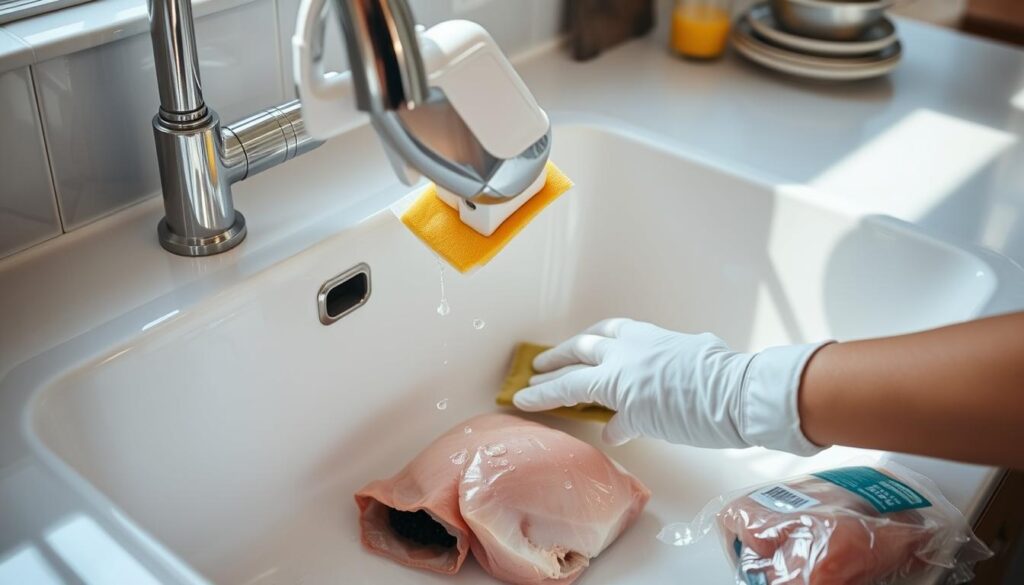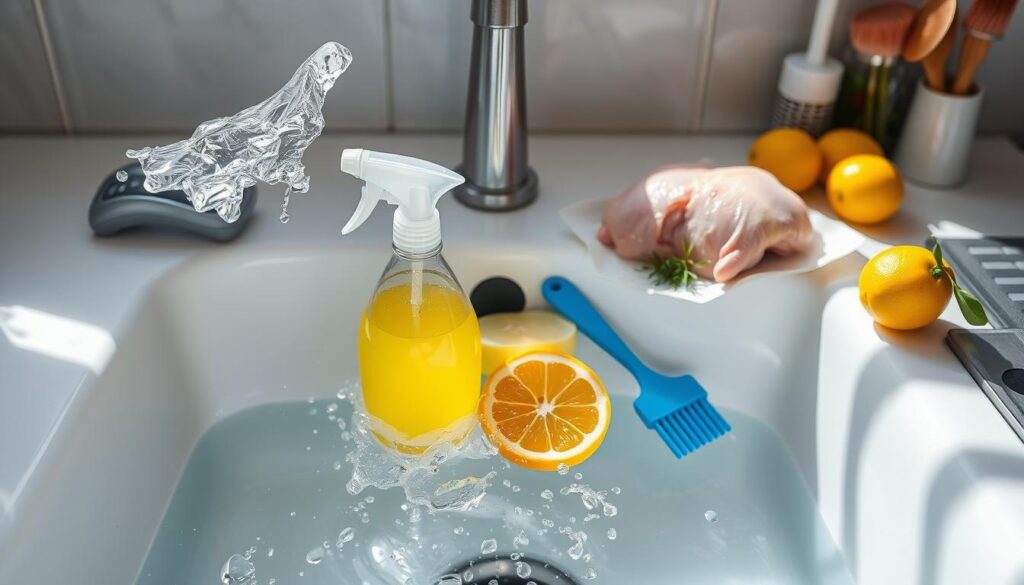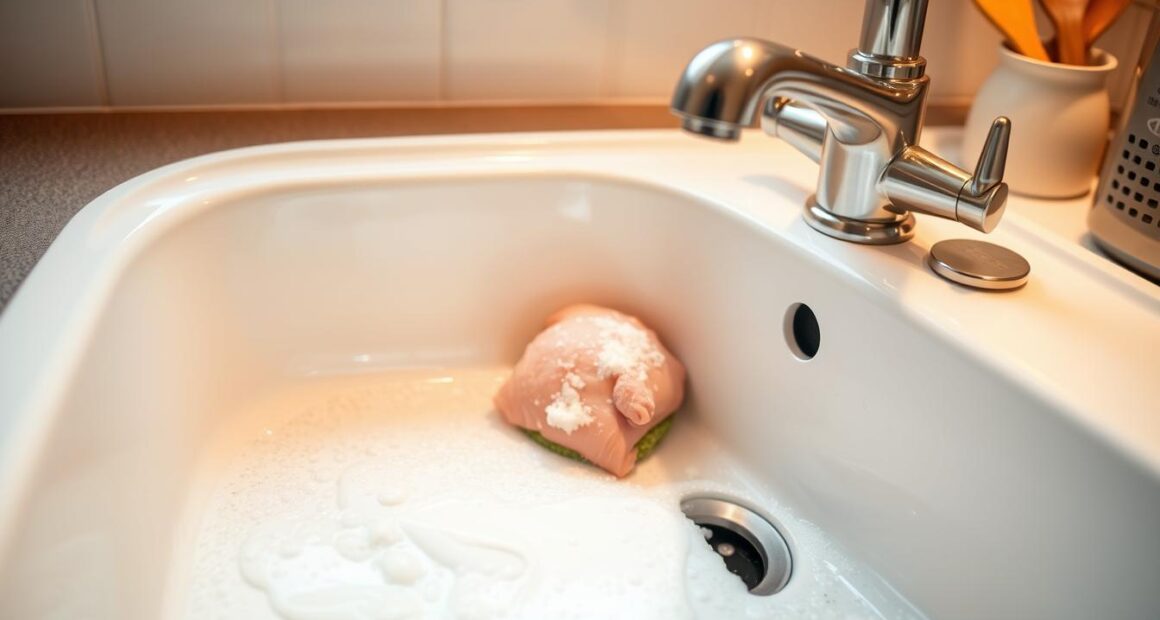Imagine this scenario: You just finished making a tasty chicken dinner. The aroma fills your kitchen. But then, you start to worry about the germs from the raw chicken in your sink. Raw chicken contains harmful bacteria like Salmonella and Campylobacter. These can spread to kitchen surfaces if not cleaned properly. To protect your family, you must clean your sink right after using it for raw chicken.
A quick wipe won’t be enough. It’s important to thoroughly clean and sanitize all kitchen surfaces to make sure your food is safe. By knowing the risks and how to clean properly, you can make your kitchen a safe place for cooking. This way, every meal will be both tasty and safe to eat.
Key Takeaways
- Raw chicken can harbor harmful bacteria that survive on surfaces for extended periods.
- Simple cleaning with warm, soapy water is not sufficient to eliminate all bacteria.
- Using a vinegar or bleach solution is recommended for effective sanitization.
- Regularly wash kitchen towels in hot water to reduce bacterial growth.
- Properly disinfect surfaces after cleaning to minimize foodborne illness risks.
- Separate utensils and cutting boards for raw meat can help avoid cross-contamination.
Understanding the Importance of Cleaning Your Sink
Keeping your kitchen sink clean is key to avoiding foodborne illnesses. This area often becomes a breeding ground for bacteria from raw chicken. These bacteria can stick around and cause contamination. You’d be surprised to find out raw poultry may contain dangerous bugs like Salmonella and Campylobacter. It’s vital to know the risks these bacteria pose to your kitchen’s safety.
Risks of Bacteria from Raw Chicken
Bacteria from raw chicken in your kitchen can be a serious health threat. These germs grow fast between 40°F and 140°F. Once they’re in your kitchen, they can spread to other spots easily. Cleaning your sink well is crucial because it’s often overlooked, but it’s a prime spot for germs to spread. Keeping your kitchen sink clean can greatly lower infection risks.
Common Foodborne Illnesses Associated with Poultry
Improper handling of chicken can lead to foodborne diseases. About 1 in 6 Americans get food poisoning each year, with 128,000 ending up in the hospital. These figures show how critical food safety practices are with raw poultry. Knowing how chicken handling links to food safety can help you keep your family safe.
The Role of the Kitchen Sink in Food Safety
Your kitchen sink is crucial for food safety. It gets dirty from raw chicken, utensils, and hands. Cleaning it regularly helps stop the spread of germs. This makes meal prep safer. Good cleaning habits for your sink protect your family’s health.
How to Clean Your Sink After Raw Chicken Safely
To keep your kitchen clean after using raw chicken, you need a good cleaning plan. This plan gets rid of not just dirt but also harmful germs. Make sure you have the right cleaning tools ready.
Step-by-Step Cleaning Process
First, wash your hands with hot, soapy water for 20 seconds. This step helps prevent spreading germs. Then, start cleaning your sink:
- Rinse the sink with hot water to remove big pieces of debris.
- Scrub every part of the sink with hot soapy water and a sponge or cloth.
- Let go of the soapy water and rinse the sink with hot water again.
- To kill germs, use a sanitizing solution. You can mix 1 tablespoon of bleach with a gallon of water or use a commercial cleaner.
- Let the sanitizer sit for 5-10 minutes for it to work well. After, rinse the sink, then dry it with a clean towel.
Preparing Your Cleaning Supplies
Having the right cleaning tools is key to getting rid of germs. You’ll need:
- Hot soapy water (hotter than 140°F works best)
- A sponge or a fresh dish rag
- A germ killer like diluted bleach or a store-bought kitchen sanitizer
- A clean towel or paper towels to dry everything
Start cleaning right after you use the sink with raw chicken. This helps stop bacteria like Salmonella from sticking around. By following these steps carefully, you keep your kitchen safe for cooking.

Effective Cleaning Techniques for Your Sink
Keeping your sink clean is crucial, especially after dealing with raw chicken. Good cleaning methods can kill harmful bacteria and keep food safe. Let’s look at three ways to clean your sink after you prep poultry.
Using Hot Soapy Water
Start with hot soapy water to clean your sink. This method removes dirt, grime, and some bacteria. Make sure the water is hot to work well. The USDA says soap doesn’t kill all bacteria but helps get surfaces ready for disinfection.
Benefits of Chlorine Bleach Solutions
Chlorine bleach kills about 99% of bacteria. Mix one tablespoon of bleach with a gallon of water to make a disinfecting solution. Let it sit for five minutes to be effective. This step is important to get rid of tough bacteria like salmonella.
Alternative Natural Disinfectants
For a natural clean, try other options. Vinegar and warm water can kill bacteria like E. coli and salmonella. It’s not as strong as bleach, though. Mixing baking soda and vinegar cleans drains with foam. Hydrogen peroxide (3%) also works as a natural disinfectant for your sink.

Best Practices to Prevent Cross-Contamination
Keeping your kitchen safe involves preventing cross-contamination. It’s important to handle utensils and cutting boards correctly. This stops bacteria from raw chicken spreading. Make sure you clean these items well after use. Following strong hygiene practices is key to a safe kitchen.
Washing Utensils and Cutting Boards
It’s important to wash utensils and cutting boards right after they touch raw chicken. To clean effectively, follow these steps:
- Use hot, soapy water to wash utensils and boards.
- Scrub thoroughly to remove any food particles.
- Sanitize with a solution of 1 tablespoon of bleach to 1 gallon of water.
These practices help keep your utensils germ-free. This reduces the chance of cross-contamination.
Keeping Kitchen Towels Safe
Your kitchen towels can also be a source of germs. To keep them clean, follow these tips:
- Wash kitchen towels frequently in hot water to kill bacteria.
- Consider designating separate towels for drying your hands and wiping surfaces.
- Replace used towels daily or as needed to further minimize risks.
By maintaining clean kitchen towels, you play a big role in preventing cross-contamination. This helps keep your food preparation area safe.

Conclusion
It’s super important to keep your kitchen safe, especially when you’ve handled raw chicken. Knowing how to clean your sink well can really cut down on the risk of getting sick from bacteria. Every year, about 48 million people in the US get sick from food, so it’s key to be careful to keep you and your family safe.
Keeping your kitchen clean isn’t just for looks; it’s about making sure your food is safe to eat. The CDC says that cooking chicken until it’s done right is crucial to kill off bad bacteria. If you clean well and cook properly, you can make your kitchen a safer place for everyone to enjoy their meals.
Following these food safety tips is pretty straightforward. Just make sure to clean thoroughly after dealing with raw chicken and watch out for spreading germs to other food. Sticking to these habits means you’re doing your part in looking after your own health and that of your family.









